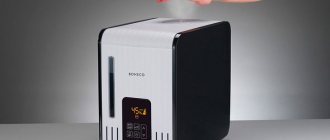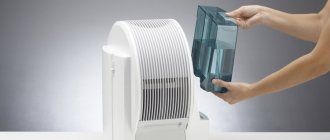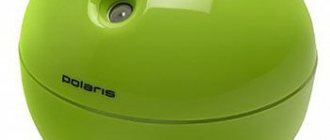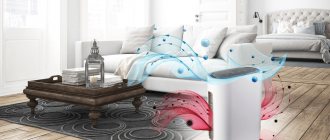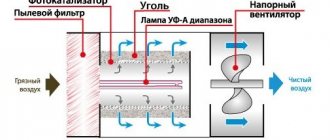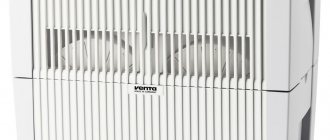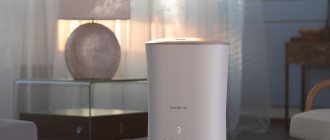In one of the previous articles, Nikita was surprised at the dirty air in Moscow (you can view the pollution index here). They say it’s a nightmare, a lot of harmful particles and you can’t breathe in it. And indeed it is.
What to do if your home air is polluted? Will a regular household cleaner do the job, or is it a waste of money?
We have found out in detail, measured and are ready to share the results of independent testing of one of the cheapest, and, at the same time, the most popular air purifiers - Xiaomi Mi Purifier 2.
ATTENTION. Testing is carried out at the expense of the editors without sponsors. The author is not interested in fraud, since he uses the tested gadget (purchased at his own expense) at home.
Air and its components: what kills us?
Conditionally harmful inclusions in the usual air that we breathe should be divided into 2 parts: inclusions from the external urban atmosphere and indoor pollution itself.
City air
The air “outside” the apartment must obey the rules described in GN 2.1.6.695-98 “Maximum permissible concentrations (MAC) of pollutants in the atmospheric air of populated areas” and a number of other regulatory documents.
According to this document, you can find almost anything outside. But in all emission zones, independent examination areas have been organized, which MUST ensure control and timely transfer of data to polluting organizations to correct the situation.
Home air
The air in our apartments is also standardized and complies with SanPiN 2.1.6.1032-01 “Hygienic requirements for ensuring the quality of atmospheric air in populated areas.”
Among the particularly dangerous air impurities characteristic of the home, it is worth mentioning formaldehyde, resins, dust (what did you think!) and a number of particles whose origin is associated with the degradation of synthetic materials: particles and fibers of plastic, asbestos, and other building mixtures.
Delivery and unpacking
The delivery went almost as usual, like all other parcels, except that the parcel hung at the sorting center of the delivery service a little longer than usual.
Just in case, I called the hotline - and on the same day the parcel was delivered to my home by a courier. The box is quite large, 58 cm high; for scale, I placed an ordinary stool next to it.
There is a sticker on the box from which you can get information about the overall dimensions - 29*29*58 cm, maximum power consumption 31 Watt, weight 6.2 kg, operating voltage 100 - 240 V.
This cardboard box, unlike, for example, the Yeelight Celling Light ceiling lamp - where there was another, beautiful white packaging inside, is the only and main one for the purifier. Inside, under the lid, there is a foam seal and the device itself.
Maximum permissible standards for components
Unfortunately, the already mentioned SanPiN 2.1.6.1032-01 does not include exact figures indicating the degree of air pollution. They are specified in GOST 12.1.005-88 “GENERAL SANITARY AND HYGIENIC REQUIREMENTS FOR WORK AREA AIR” and GOST 30494-2011 “RESIDENTIAL AND PUBLIC BUILDINGS. Indoor microclimate parameters."
According to GOST 30494-2011, the main pollutants are carbon dioxide CO2 (gas released during breathing) and CO (equivalent to emissions of finishing materials) with a maximum content for apartments of 400 cm3/m3 and 2–6 mg/m3. respectively.
The mentioned CO in real life is represented by so-called VOCs - these are gases and aerosols emitted by paints, varnishes, cleaning and disinfectants, building materials, furniture, office equipment, glues and adhesives.
For each substance, there are standards described in GOST 12.1.005-88, which can be inhaled or consumed in another way for a certain time without serious consequences for the body.
The problem with Russian regulations is the lack of mention of particle dispersion. The fact is that not only the chemical composition of impurities is important for the human body, but also the size of the inclusions.
Airborne particles are divided by size:
- large particles with a diameter > 10 µm
- PM10 fine particles with diameter
- PM2.5 fine particles with diameter
- ultrafine particles PM0.3 with a diameter
The most dangerous are the last 2 types.
Effect of PM2.5 particles on humans
PM2.5 particles are called the respirable, inhalable fraction. They are so small that they pass through biological barriers in our body: the nasal cavity, upper respiratory tract, bronchi and enter directly into the alveoli of the lungs, from where they enter the blood.
Ultrafine particles act in a similar way, but tend to accumulate in the lungs, and when they enter the blood, they act immediately and can cause an oxidative process.
How to deal with harmful impurities
There are several types of home air purification devices, among which filtering devices are deservedly more popular. And that's why.
Air washers force air through a water filter, removing large particles from it. Have to wash it often.
Electrostatic cleaners first charge the air they pass through, then attract particles to the oppositely charged cleaning plate. They produce too much ozone and require constant cleaning.
Photocatalytic purifiers use a photofilter, which, by releasing certain particles, causes impurities to decompose into components, oxidize and settle on the walls of the filter. They require enormous power and are most often ineffective.
Ionic purifiers must charge air impurities in order to attract them with a special filter. Alas, not all impurities can be charged, and in general, filters of this type have unconfirmed effectiveness.
Filter purifiers pass air through several filters that capture the appropriate types of particles. Requires periodic filter replacement.
Inertial cleaners accelerate the air flow in the form of a cyclone so that the dust settles on the filter walls.
Does not remove small particles.
How to choose an air purifier?
A significant part when purchasing an air purifier is the built-in filter.
According to the classification, filters are divided into 3 types:
- Rough cleaning;
- Fine cleaning – HEPA (High Efficiency Particulate Arresting) filter;
- Carbon filter;
- Electrostatic;
- Water filter.
Important factors are technical characteristics:
- Noise level . If you work at night or in a nursery, you should take care to keep the noise level low - about 30 dB;
- Adjustable work intensity . During the daytime, the device works at full strength; at night, the intensity decreases;
- Productivity . The indicator is responsible for the volume of air that the device processes in one hour. Treatment 2-3 times per hour is considered a good result. To accurately determine, you need to know the volume of the room.
It will be important to have a timer, installation methods and an indicator of the level of filter contamination.
Xiaomi Corporation produces a variety of air purifiers, both in terms of technical characteristics and pricing policy.
Let's look at the most popular and high-quality ones.
We are testing Xiaomi Mi Purifier 2. Is there any benefit?
Xiaomi Mi Air Purifier 2 is the second modification of the air purifier from Xiaomi, designed for less polluted conditions than Beijing and Shanghai. In addition, international experts participated in its certification, so the results of the device meet international requirements, unlike previous modifications.
The device is designed to clean rooms up to 330 cubic meters in volume, or up to 46 square meters in area, using a replaceable filter combining HEPA (fine filter) and carbon.
According to official data, the purifier can purify the air from small particles hazardous to health in the categories PM0.3 - up to 99.5%, PM2.5 - up to 99.7%, formaldehyde - up to 91%, large particles hazardous to health - up to 100% .
Using the proprietary MiHome and built-in sensors, the device reports data on temperature and humidity in the room and the concentration of PM2.5 particles. In addition, if open data is available, it is possible to find out information about the air quality outside the window.
In fact, the main sensor is a dust sensor, and cannot detect the type of particles. Therefore, the device's own data are incomplete for accurately assessing indoor air quality.
However, this is enough to understand the effectiveness of the filter. No one has canceled subjective assessments either.
ATTENTION. Xiaomi Mi Purifier measures the amount of PM2.5 particles not in SI units! The values shown are the air quality index according to The World Air Quality Index .
Rating of popular models
Having decided to purchase a functional device from a well-known Chinese company, you should consider several models proposed by the manufacturer, which are considered the most successful and economical .
Below is a rating of the best models with a short review, pros and cons based on customer ratings and reviews.
#1
Xiaomi Mi Air Purifier 2S (FJY4020GL)
An ultra-modern device that will fit perfectly into the interior of any room.
The Xiaomi Mi Air Purifier 2S model has simple shapes, graceful edges and a snow-white color.
The purifier works by drawing air through holes on the sides, passing it through filters and returning it back into the room through a fan located at the top.
Thanks to the HEPA filter, all small suspended particles, including germs and bacteria, are removed from the atmosphere.
Specifications:
- serviced area - 37 sq.m.;
- number of speeds - 3;
- features - HEPA filter;
- presence of display - yes;
- display type - OLED;
- connection type - Wi-Fi.
Advantages
- stylish design;
- there is much less dust;
- works in conjunction with the application and without it;
- silent.
Flaws
- expensive filter;
- to connect in the application you need to select the Chinese region;
#2
Xiaomi Mi Air Purifier Pro (FJY4013GL)
Unique tower-type air purifier with improved air injection system.
The Xiaomi Mi Air Purifier Pro model has an increased fresh air supply rate.
Without creating unnecessary noise, the device adsorbs fine dust, formaldehyde and other pollutants.
The device has a primary filtration mesh and a high-quality carbon filter, thanks to which even negligible dust molecules disappear from the room.
Specifications:
- serviced area - 60 sq.m.;
- control - electronic;
- hygrostat - yes;
- maximum air exchange - 500 cubic meters/hour;
- ionization - no;
- control of microclimate cleanliness - yes.
Advantages
- very quiet in auto mode;
- there is a timer for working on days of the week;
- futuristic design;
- mobile application with remote access.
Flaws
- Airflow power modes can only be adjusted in the app;
- stands unsteadily on carpet;
- The mobile app is inconvenient.
#3
Xiaomi Mi Air Purifier 2
A modern home assistant designed to purify polluted air that negatively affects overall well-being.
An air purifier with light-sensitive sensors, filter contamination indication and a display for comfortable monitoring of the operating process.
The electrical appliance is controlled using a mobile application pre-installed on your smartphone.
To clean the atmosphere as quickly as possible, the owner will only have to go to the application and press a button.
Specifications:
- power consumption – 28 W;
- filters – carbon, pre-cleaning;
- control – electronic;
- installation – floor;
- Dimensions – 24x52x24 cm.
Advantages
- adjustment of work speed;
- remote control;
- work in the “smart home” system;
- selection of evaporation intensity;
- Convenient movement of the device.
Flaws
- floor installation only;
- additional costs for replacement filters;
- high noise level in certain modes.
#4
Xiaomi Mi Car Air Purifier
A portable device for a car that will filter the air in the car from harmful particles in a short time.
The Xiaomi Mi Car Air Purifier is equipped with a filter cartridge that can purify the air in the car in just 3 minutes.
The special design, equipped with two fans, optimizes the direction of oxygen flow so that purified streams can circulate throughout the cabin.
The American dust sensor will show the PM2.5 level in the microclimate in real time.
Specifications:
- productivity - 60 cubic meters/h;
- control - electronic;
- noise level - 42 dB;
- indication - filter contamination;
- control from a smartphone - yes.
Advantages
- convenient fastening;
- cleanses the atmosphere well;
- removes the smell of tobacco.
Flaws
- useless when the hatch or window is open;
- If you turn it on during the cold season, it becomes even colder in the car.
#5
Xiaomi Smartmi Fresh Air System Wall Mounted Air Purifier
A supply air purifier that will provide a supply of fresh air from the street and relieve the user from the need to ventilate the room.
The Xiaomi Smartmi Fresh Air System Wall Mounted model is a new type of device that takes air from the street, filters it and supplies it to the house.
The device has low power consumption of 48 W, which is important for a modern person.
Control takes place using a phone or tablet.
Specifications:
- filter - three-level;
- productivity - 220 cubic meters/hour;
- noise level - 41 dB;
- control from a smartphone - yes;
- installation - wall.
Advantages
- the air flow is not noticeable even close to the device;
- there is no need to construct an exhaust duct;
- convenient control;
- suitable for large rooms;
Flaws
- difficult to install;
- no heating function.
#6
Air purifier Xiaomi Mi Air Purifier Max
A powerful cleaner with unrivaled performance up to 1000 cubic meters. air per hour.
The purifier of this model has the ability to independently adapt to the volume of the room being treated.
The innovative oxygen intake system aims to increase the incoming and outgoing flow.
High-precision laser sensors detect even the smallest dust particles in the atmosphere.
Changes in the quality of the microclimate are displayed on the device display.
Specifications:
- noise level - 34 dB;
- serviced area - 120 sq.m.;
- hygrostat - yes;
- adjustment - yes;
- remote control - no.
Advantages
- highest performance;
- large display;
- minimal noise;
- dust mesh in front of the filters;
Flaws
- You cannot turn off one fan;
- no bluetooth.
Test 1. Own readings, normal conditions
The first home test was carried out in an ordinary room in a city apartment in a district of Ulyanovsk under construction. The local air cannot be compared with Moscow - less than a kilometer from the Volga, the winds of the city on seven hills and the vast park area cope well with urban impurities.
The switching-on was carried out in a closed room, which was not ventilated for 10 hours, and was not cleaned for a week (the authors make incredible self-sacrifice for you) for sufficient accumulation of dust.
Left - readings before switching on, right - after cleaning
As can be seen from the results, the home accessory copes well with common household impurities in the form of fine dust and “repair” components - substances emitted by finishing materials.
The next test was carried out with an open window, simulating external urban conditions. Outside the window there is complete calm, a hot day (rising currents from the ground raise the remaining amount of dust, there is not much of it).
Left - readings before switching on, right - after cleaning
The result is not as happy as in a completely enclosed room. However, the level of impurities does not exceed the standards established in GOST. Using a cleaner slightly reduces their level.
Test 2. Own readings, polluted air
Additional testing of the Xiaomi purifier was carried out to study its performance with the most polluted air.
Tobacco smoke, oil smoke, and burnt wood were used as air impurities. Such components qualitatively simulate emissions from thermal power plants, boiler houses and enterprises.
Left - readings before switching on, right - after cleaning
The effectiveness of the device is confirmed: Mi Purifier 2 copes with any smoke in approximately the same time, regardless of its density and saturation.
The built-in sensor probably measures an average value, since lighter tobacco smoke should settle on the filters more slowly.
What is necessary to reduce the concentration index of particles with a diameter of 2.5 microns [micrometers] from 410 to an acceptable 44 can be seen in the screenshots. However, in real conditions, longer time may be required since smoke uniformity was controlled subjectively.
The subjective assessment was made by a person entering the room after complete cleaning. There are no smoke odors, but a close inspection of the purifier suggests it needs to be ventilated.
Purifier device
Air filter
During transportation, in the internal compartment, in addition to the filter, there are also instructions and a power cable.
On the inside of the cover, in Chinese, but in clear pictures, the process of replacing the air filter and cleaning the dust sensor is depicted
The air filter has a diameter of 20 and a height of 30 cm
The filter has a multilayer structure - close-up of the outer part
Interior
Power cable
Gray cable, 6 feet long, approximately 1.8 meters
Plug - Type I, triple - Chinese-Australian-New Zealand.
But on the other hand, there is a relatively standard triple connector, often found, for example, when connecting to laptop power supplies. I found a suitable cable in my stash
Which fits perfectly with the purifier - eliminating the need to change the plug on the original cable
Although personally, I don’t need this, thanks to extension cords from Xiaomi - using which I don’t have to think about whether the plug will fit or not.
Fan
During normal operation in automatic mode and in sleep mode (the fan rotates in all modes except the off mode), the noise of the engine and fan is completely inaudible.
By the way, if you look from the inside, you can see that the fan is double
When the concentration of dust in the air increases, or when forced into forced mode, air noise is heard, at most comparable to the operation of a robotic vacuum cleaner, only the noise of the air, not the engine, predominates.
Test 3. Industrial grade laboratory tests
This is how PM2.5 particles work. To confirm the functionality of the device, we used the help of an industrial cleanliness laboratory at a local company located near where I live.
The device was placed in a sealed room with a volume of 20 cubic meters, filled with air purified from impurities and PM10/2.5/0.3 particles.
Test substances were introduced into the room one by one. Cleaning percentage:
- Ammonia - 92%
- Hydrogen sulfide - 97%
- Phenol - 97%
- Methane - 99%
- Carbon dioxide - 98%
- Formaldehyde - 95%
- PM10 - 98%
- PM2.5 - 97%
- PM0.3 - 86%
The results are slightly worse than those officially declared, however, they do not reduce the effectiveness of the device, since the content of introduced substances after purification does not exceed the permissible limits.
Rating of the TOP 7 best Xiaomi air humidifiers of 2020-2021
| Place | Name | Price |
| TOP 7 best inexpensive Xiaomi air humidifiers | ||
| 1 | Xiaomi CJXJSQ02ZM | Find out the price |
| 2 | Xiaomi DEM-F600 | Find out the price |
| 3 | Xiaomi DEM-SJS600 | Find out the price |
| 4 | Xiaomi CJJSQ01ZM | Find out the price |
| 5 | Xiaomi JSQ01ZM | Find out the price |
| 6 | Xiaomi DEM-SJS100 | Find out the price |
| 7 | Xiaomi SCK0A45 | Find out the price |

